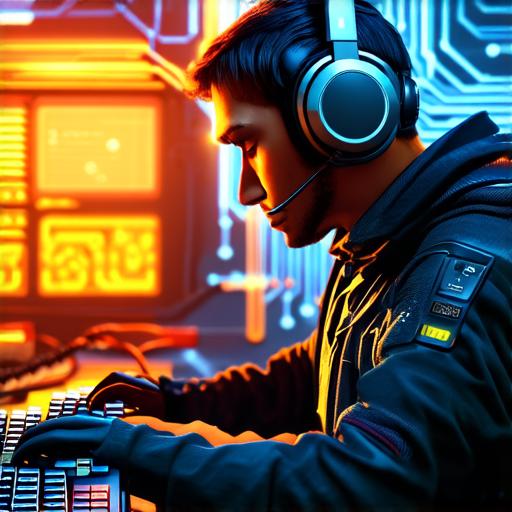The art of creating a computer video game is a complex process that requires knowledge in programming, game design, art, and more. In this comprehensive guide, we will walk you through the steps of how to make a computer video game from scratch, covering everything from brainstorming ideas to coding and testing. We’ll also discuss best practices and tips for creating engaging games that captivate players and keep them coming back for more.
Now that we’ve covered what a video game is let’s explore how to make one.
Step 1: Brainstorming and Conceptualization
The first step in creating a computer video game is brainstorming ideas and conceptualizing the game mechanics, story, and overall experience. This process involves coming up with a unique idea that stands out from other games on the market. It’s important to have a clear understanding of what makes your game unique and how it will engage players.
When brainstorming ideas, consider your target audience and what they would enjoy playing. For example, if you’re targeting a younger demographic, you may want to create an action-packed game with colorful graphics and fast-paced gameplay. On the other hand, if you’re targeting an older demographic, you may want to create a puzzle or strategy game that challenges players intellectually.
Once you have a general idea of what kind of game you want to create, it’s time to start conceptualizing the mechanics and overall experience. This involves creating a rough outline of how the game will work, including any puzzles, enemies, or other game elements. It’s important to keep the game mechanics simple and easy to understand, as complex controls can be frustrating for players.
Step 2: Game Design and Prototyping
The next step in creating a computer video game is game design and prototyping. This involves taking the concepts you brainstormed earlier and turning them into a tangible prototype that players can interact with.
When designing the game mechanics, consider using a programming language such as Unity or Unreal Engine. These engines provide a visual interface for designing game mechanics and allow you to create interactive prototypes without writing code from scratch. However, if you prefer to write code yourself, you can use languages such as C++, Java, or Python.
Once you have a prototype, it’s important to test it with a group of people to get feedback on what works and what doesn’t. This will help you refine the mechanics and create a more engaging game experience.
Step 3: Art Assets and Animation
The next step in creating a computer video game is creating art assets and animation. This involves designing the graphics, sound effects, and other elements that make up the game’s visual and audio components.
When creating art assets, consider using software such as Adobe Photoshop or Blender. These tools allow you to create high-quality images and animations with a wide range of customization options. It’s important to keep the art style consistent throughout the game to maintain a cohesive visual experience.
When creating animation, it’s important to consider the character’s movements and actions. Animations should be fluid and natural, making it easy for players to understand what the character is doing and how they can interact with it.
Step 4: Sound Design and Music
The next step in creating a computer video game is sound design and music. This involves creating the audio elements that make up the game’s soundscape, including background music, sound effects, and voice acting.
When designing sound, it’s important to consider how the sounds will interact with each other and the gameplay mechanics. For example, a loud explosion sound may be distracting in a quiet puzzle-based level. When creating music, it’s important to consider the mood and atmosphere of the game and create a score that enhances the overall experience.
Step 5: Programming and Coding
The next step in creating a computer video game is programming and coding. This involves writing code to implement the mechanics, art assets, animation, sound design, and music into the game engine.
When programming, it’s important to follow best practices such as using comments to explain your code, breaking down complex functions into smaller, more manageable pieces, and testing your code regularly. There are many resources available online for learning how to program video games, including tutorials and online courses.
Step 6: Testing and Debugging
The final step in creating a computer video game is testing and debugging. This involves thoroughly testing the game to ensure that it works as intended and identifying any bugs or issues that need to be fixed.
When testing, it’s important to consider different scenarios and edge cases to ensure that the game functions correctly under all circumstances. It’s also important to get feedback from players and incorporate their suggestions into the game design.

FAQs
What are some common mistakes people make when creating a computer video game?
- Overcomplicating the game mechanics or controls
- Poorly designing the art assets or animation
- Not testing the game thoroughly enough
- Ignoring player feedback and suggestions
How long does it take to create a computer video game from scratch?
The amount of time it takes to create a video game depends on the complexity of the game, the team size, and the resources available. A simple 2D platformer can take anywhere from a few months to a year or more to complete. More complex games with advanced graphics, animation, and sound design can take several years to complete.
What skills are needed to create a computer video game?
- Programming (C++, Java, Python)
- Game design
- Art and animation
- Sound design
- Project management
- Communication and collaboration skills
Summary
Creating a computer video game is a complex process that requires a combination of technical and creative skills. By following the steps outlined in this guide and paying attention to detail, you can create an engaging and immersive game that captivates players and keeps them coming back for more. Remember to stay focused on your target audience, test your game thoroughly, and incorporate player feedback into the design process. With dedication and hard work, you can bring your game ideas to life and share them with the world.
